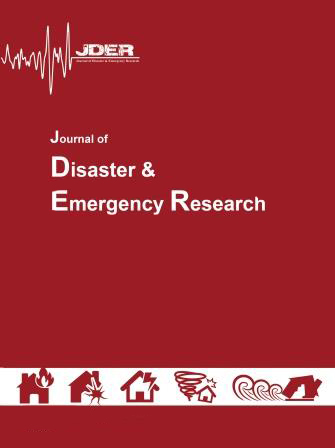Authors
1 1 MSc in Medical Information and Librarianship, School of Public Health, Shahid Sadoughi University of Medical Sciences, Yazd, Iran
2 2 Department of Health Management and Economics, School of Public Health, Shahid Sadoughi University of Medical Sciences, Yazd, Iran
3 3 Department of Health Management and Economics, School of Public Health, Tehran University of Medical Sciences, Tehran, Iran
Keywords
Knowledge management can effectively reduce the adverse effects of disasters such as earthquakes on people (3). Knowledge management with the help of social media technology has played an important role in managing and integrating knowledge and learning activities (4).
Social media has its specific features in the realization of the overall knowledge management process, which includes the exchange of knowledge among users, knowledge feedback and knowledge transfer (5). Social media has emerged as a potential source for improving crisis management for natural disasters (6) and with emergency information dissemination to the community affected by the disaster, plays an important role in crisis management. Moreover, social media is considered as one of the most popular sources for accessing emergency information (7).
A study done by Mukkamala et al. showed that ordinary people disseminate timely information about the disaster situation which can be used by relief organizations, in natural disasters (8). According to the Gurman and Ellenberger study, organizations need to make more use of social media network tools in disaster to provide timely and responsive communication with the people (9).
In relation to the analysis of the use of social media in emergencies and disasters, the research organizations are growing, and social media has been concentrated as an independent source of information (6). The main benefits of social media are: 1- Timeliness of knowledge 2- Encouraging people to participate in disaster 3- Improving the efficiency of knowledge (5). Most of the messages contain information for updating the status, either as primary and content source or secondary source and retrieved from other sources (8). The problems of social media management in disaster response are the failure to ensure the reality of shared knowledge, knowledge security, and the lack of classified reserves as a traditional knowledge management system (5).
Given the widespread use of social media, it can be used as one of the most important tools for informing and educating people about disaster preparedness measures, so that knowledge management and transfer can take place. The various organizations that operate in times of natural disaster can also use social networks available to the public to disseminate the necessary information, prompt alerts, relief methods and warnings. It prompts users to get up-to-date information, so false information is less spread, and the relevant organizations provide a protocol and solution to solve the problems expressed in social media knowledge management
Acknowledgments
Thanks are owed to those who cooperated in writing the manuscript.
Funding source
None
Conflict of interest
None declared
Authors' contribution
All authors contributed to this project and article equally. All authors read and approved the final version of the manuscript.
- Sepehri M, Riahi A. Social Network Analysis Application for Knowledge Management System Needs Elicitation in Knowledge-Based Organizations. Journal of Science & Technology Policy. 2011;3(2):81-94. [Persian]
- Ghafarian Sokhanvar Z, Hosseingholizadeh R, Noghani Dokht Bahmani M. The function of social network analysis in managing knowledge capitals of organization. 8th knowledge management conference 23-24 feb 2016; beheshti international conference center Tehran. 2016. [Persian]
- Deshmukh R, Rodrigues LL, Krishnamurthy G. Earthquake risk and knowledge management.Journal of Knowledge Management Practice. 2008;9(3).
- Rampai N. The Development Model of Knowledge Management via Social Media to Enhance Graduated Student's Self-Directed Learning Skill In: Procedia-Social and Behavioral Sciences, editor. 13th International Educational Technology Conference Sakarya Universitesi, Turkey. Sakarya Universitesi, Turkey: Elsevier 2013. p. 1006-10 [DOI:10.1016/j.sbspro.2013.10.425]
- Wei Z, Qingpu Z, Wei S, et al. Role of social media in knowledge management during natural disaster management. Advances in Information Sciences and Service Sciences. 2012;4(4):41-45.
- De Albuquerque JP, Herfort B, Brenning A, et al. A geographic approach for combining social media and authoritative data towards identifying useful information for disaster management. International Journal of Geographical Information Science. 2015;29(4): 667-89. [DOI:10.1080/13658816.2014.996567]
- Kim J, Hastak M. Social network analysis: Characteristics of online social networks after a disaster International. International Journal of Information Management. 2018;38(1):86-96. [DOI:10.1016/j.ijinfomgt.2017.08.003]
- Mukkamala A, Beck R. Enhancing Disaster Management Through Social Media Analytics To Develop Situation Awareness What Can Be Learned From Twitter Messages About Hurricane Sandy? Proceeding Pacific Asia Conference on Information Systems; 2016: p.165. Available at: http://aisel.aisnet. org/ pacis2016/ 165
- Gurman TA, Ellenberger N. Reaching the global community during disasters: findings from a content analysis of the organizational use of Twitter after the 2010 Haiti earthquake. Journal of Health Communication. 2015; 20(6): 687-96. [DOI:10.1080/10810730.2015.1018566] [PMID]

